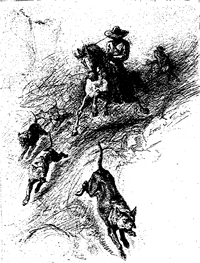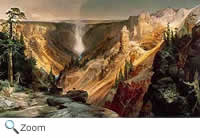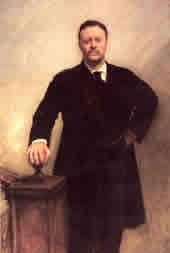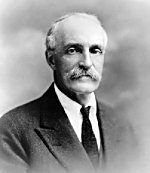Controlling Nature  When the first European colonists came to the New World, they were impressed with the natural resources they found. They viewed the natural world as something that was to be used, tamed, and controlled by man. Their days were spent working the land, hunting, and simply surviving. If an animal was a threat, like the wolf or the mountain lion, then they wanted to eliminate it. If they needed more land to farm, they drained a marsh or cut down a forest. They really didn't have the time to simply appreciate nature for itself! That view of the role of nature was common until the mid 1800s when the Conservation Movement was born. When the first European colonists came to the New World, they were impressed with the natural resources they found. They viewed the natural world as something that was to be used, tamed, and controlled by man. Their days were spent working the land, hunting, and simply surviving. If an animal was a threat, like the wolf or the mountain lion, then they wanted to eliminate it. If they needed more land to farm, they drained a marsh or cut down a forest. They really didn't have the time to simply appreciate nature for itself! That view of the role of nature was common until the mid 1800s when the Conservation Movement was born.
Preserving Nature The Conservation Movement was at its height between 1850-1920 and was the result of a number of social and economic factors. The movement's goal was to preserve and promote the wise use of the nation's natural resources, and it led to the development of national parks; flood control; reforestation; and the preservation of minerals, soil, water, and wildlife resources.
A Break from the City  During this period, more and more people were leaving rural towns and villages for jobs in the cities. As they left their farms behind and moved into crowded and dirty cities, they developed a sentimental attachment to what they had left behind and a desire to preserve the natural landscape where they could and to create places where they could escape the pressures of the city. Improvements in transportation and more leisure time allowed Americans to take up camping, hiking, bird watching, and other outdoor activities as a way to escape crowded cities. Places like Central Park in New York were built to serve as an oasis for weary city dwellers. During this period, more and more people were leaving rural towns and villages for jobs in the cities. As they left their farms behind and moved into crowded and dirty cities, they developed a sentimental attachment to what they had left behind and a desire to preserve the natural landscape where they could and to create places where they could escape the pressures of the city. Improvements in transportation and more leisure time allowed Americans to take up camping, hiking, bird watching, and other outdoor activities as a way to escape crowded cities. Places like Central Park in New York were built to serve as an oasis for weary city dwellers.
Power of Organization During the Conservation Movement local and national groups formed to help promote conservation and protect natural resources.
In 1897 in Manchester, New Hampshire, Mrs. Arthur E. Clarke held a meeting in her house to organize the New Hampshire Audubon Society. One of the goals of the newly formed society was to teach school children about birds. The group formed a junior Audubon society and created an Outline of Bird Study for schools and held contests for students.
Contest for New Hampshire Students
Two prizes, one of ten dollars and one of five dollars to children over twelve and under seventeen years of age; and two more, one of five dollars and one of three dollars to children under twelve years of age. These prizes are to be awarded for the best compositions on 'Birds,' the compositions to be written as the result of personal observation, composition the contest to close January 1, 1900.
Bird lore, vol. 1., New York City : Macmillan Co., c1899-c1940. |
|
|
|
|
The Power of Words and Pictures Artists, photographers, and writers were capturing and writing about the natural landscape of the West. When Americans saw these works they realized that those areas needed to be protected from the kind of development that had changed the landscape in the East.
 In 1898, Ernest Seton Thompson published a multivolume collection, Wild Animals I Have Known. In his book he wrote about his observations of North American wildlife. The best-selling book introduced Americans to accurate profiles animals like the wolf that they had previously feared. Seton went on to found an organization to teach wilderness skills to boys called the Woodcraft Indians. The Woodcraft Indians was a precursor to the Boy Scouts of America and Seton helped draft the first Boy Scout manual and in 1912 became the first editor of Boy's Life magazine. Read some stories from Wild Animals I Have Known! In 1898, Ernest Seton Thompson published a multivolume collection, Wild Animals I Have Known. In his book he wrote about his observations of North American wildlife. The best-selling book introduced Americans to accurate profiles animals like the wolf that they had previously feared. Seton went on to found an organization to teach wilderness skills to boys called the Woodcraft Indians. The Woodcraft Indians was a precursor to the Boy Scouts of America and Seton helped draft the first Boy Scout manual and in 1912 became the first editor of Boy's Life magazine. Read some stories from Wild Animals I Have Known!
A Picture's Worth a 1000 Words
 In 1871, the U.S. government sent a team led by
Ferdinand
Hayden
on an expedition to Yellowstone. Two of the members of the group were landscape artist Thomas Moran and photographer
William H. Jackson. The nature images that these two artists brought back from the expedition convinced Congress and the public that Yellowstone needed to be protected. In 1872,
President Ulysses S. Grant designated Yellowstone as the United States first national park. In 1871, the U.S. government sent a team led by
Ferdinand
Hayden
on an expedition to Yellowstone. Two of the members of the group were landscape artist Thomas Moran and photographer
William H. Jackson. The nature images that these two artists brought back from the expedition convinced Congress and the public that Yellowstone needed to be protected. In 1872,
President Ulysses S. Grant designated Yellowstone as the United States first national park.
Power of the President  President Theodore Roosevelt was an avid outdoors man and hunter and also played a critical role in the Conservation Movement. President Theodore Roosevelt was an avid outdoors man and hunter and also played a critical role in the Conservation Movement.
In 1903, he established the first
federal
bird
refuge at Pelican Island, Florida in order to protect
the last rookery of brown pelicans on the east coast of Florida. Roosevelt went on to
establish 51 bird reservation and national game preserves for wildlife. These were the forerunners to today's national wildlife refuge system and the first U.S. government attempt to set aside land to protect wildlife.
 In 1905, the National Forest Service was established and
Gifford Pinchot
was made the new service's director.
Gifford Pinchot was the first
professionally trained forester in America! Pinchot worked hard to bring professional management and scientific principles to managing the nation's forests. By 1910, the Forest Service had established 150 national forests! In 1905, the National Forest Service was established and
Gifford Pinchot
was made the new service's director.
Gifford Pinchot was the first
professionally trained forester in America! Pinchot worked hard to bring professional management and scientific principles to managing the nation's forests. By 1910, the Forest Service had established 150 national forests!
In 1908, President Roosevelt hosted the
The Conference of Governors at the White House to examine conservation issues. The conference was attended by governors, scientists, and business and conservation leaders.
Following the meeting, the National Conservation Commission was formed and made the first inventory of the nation's natural resources. In the following year, the governors of 41 states developed their own Conservation Commissions.
Roosevelt also created five National Parks and four National Game Preserves.
|

 When the first European colonists came to the New World, they were impressed with the natural resources they found. They viewed the natural world as something that was to be used, tamed, and controlled by man. Their days were spent working the land, hunting, and simply surviving. If an animal was a threat, like the wolf or the mountain lion, then they wanted to eliminate it. If they needed more land to farm, they drained a marsh or cut down a forest. They really didn't have the time to simply appreciate nature for itself! That view of the role of nature was common until the mid 1800s when the Conservation Movement was born.
When the first European colonists came to the New World, they were impressed with the natural resources they found. They viewed the natural world as something that was to be used, tamed, and controlled by man. Their days were spent working the land, hunting, and simply surviving. If an animal was a threat, like the wolf or the mountain lion, then they wanted to eliminate it. If they needed more land to farm, they drained a marsh or cut down a forest. They really didn't have the time to simply appreciate nature for itself! That view of the role of nature was common until the mid 1800s when the Conservation Movement was born.  During this period, more and more people were leaving rural towns and villages for jobs in the cities. As they left their farms behind and moved into crowded and dirty cities, they developed a sentimental attachment to what they had left behind and a desire to preserve the natural landscape where they could and to create places where they could escape the pressures of the city. Improvements in transportation and more leisure time allowed Americans to take up camping, hiking, bird watching, and other outdoor activities as a way to escape crowded cities. Places like Central Park in New York were built to serve as an oasis for weary city dwellers.
During this period, more and more people were leaving rural towns and villages for jobs in the cities. As they left their farms behind and moved into crowded and dirty cities, they developed a sentimental attachment to what they had left behind and a desire to preserve the natural landscape where they could and to create places where they could escape the pressures of the city. Improvements in transportation and more leisure time allowed Americans to take up camping, hiking, bird watching, and other outdoor activities as a way to escape crowded cities. Places like Central Park in New York were built to serve as an oasis for weary city dwellers.  In 1898, Ernest Seton Thompson published a multivolume collection, Wild Animals I Have Known. In his book he wrote about his observations of North American wildlife. The best-selling book introduced Americans to accurate profiles animals like the wolf that they had previously feared. Seton went on to found an organization to teach wilderness skills to boys called the Woodcraft Indians. The Woodcraft Indians was a precursor to the Boy Scouts of America and Seton helped draft the first Boy Scout manual and in 1912 became the first editor of Boy's Life magazine. Read some stories from
In 1898, Ernest Seton Thompson published a multivolume collection, Wild Animals I Have Known. In his book he wrote about his observations of North American wildlife. The best-selling book introduced Americans to accurate profiles animals like the wolf that they had previously feared. Seton went on to found an organization to teach wilderness skills to boys called the Woodcraft Indians. The Woodcraft Indians was a precursor to the Boy Scouts of America and Seton helped draft the first Boy Scout manual and in 1912 became the first editor of Boy's Life magazine. Read some stories from 
 President Theodore Roosevelt was an avid outdoors man and hunter and also played a critical role in the Conservation Movement.
President Theodore Roosevelt was an avid outdoors man and hunter and also played a critical role in the Conservation Movement.  In 1905, the National Forest Service was established and
Gifford Pinchot
was made the new service's director.
Gifford Pinchot was the first
professionally trained forester in America! Pinchot worked hard to bring professional management and scientific principles to managing the nation's forests. By 1910, the Forest Service had established 150 national forests!
In 1905, the National Forest Service was established and
Gifford Pinchot
was made the new service's director.
Gifford Pinchot was the first
professionally trained forester in America! Pinchot worked hard to bring professional management and scientific principles to managing the nation's forests. By 1910, the Forest Service had established 150 national forests!